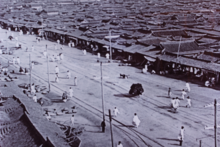Street in Seoul, South Korea
.mw-parser-output .hidden-begin{box-sizing:border-box;width:100%;padding:5px;border:none;font-size:95%}.mw-parser-output .hidden-title{font-weight:bold;line-height:1.6;text-align:left}.mw-parser-output .hidden-content{text-align:left}@media all and (max-width:500px){.mw-parser-output .hidden-begin{width:auto!important;clear:none!important;float:none!important))You can help expand this article with text translated from
the corresponding article in Korean. (September 2022) Click [show] for important translation instructions.
Machine translation, like
DeepL or
Google Translate, is a useful starting point for translations, but translators must revise errors as necessary and confirm that the translation is accurate, rather than simply copy-pasting machine-translated text into the English Wikipedia.
Do not translate text that appears unreliable or low-quality. If possible, verify the text with references provided in the foreign-language article.
You must provide
copyright attribution in the
edit summary accompanying your translation by providing an
interlanguage link to the source of your translation. A model attribution edit summary is Content in this edit is translated from the existing Korean Wikipedia article at [[:ko:종로 (서울)]]; see its history for attribution.
You may also add the template ((Translated|ko|종로 (서울))) to the
talk page.
For more guidance, see
Wikipedia:Translation.
Jongno or Jong-ro (Korean: 종로; lit. Bell Street) is a trunk road and one of the oldest major east–west thoroughfares in Seoul, South Korea.[1] Jongno connects Gwanghwamun Plaza to Dongdaemun.
The area surrounding Jongno is a part of Downtown Seoul and one of the most prominent cultural, historical, and financial areas. Many important landmarks are located along its length, including the Bigak pavilion at Sejongno, the Bosingak belfry (hence the street's name), Tapgol Park (Pagoda Park), the Jongmyo royal ancestral shrine, and the Dongdaemun (Great East Gate). Seoul Subway Line 1 passes under Jongno. The western end of Jongno is serviced by Gwanghwamun Station (Seoul Subway Line 5), and Jongno 3-ga Station is serviced by Subway Lines 1, 3, and 5. Because of the multitude of shops, stores, and groceries along the area, the word "Jongno" is often used in the Korean language to express "Town Square."


